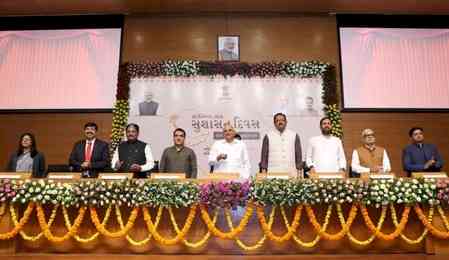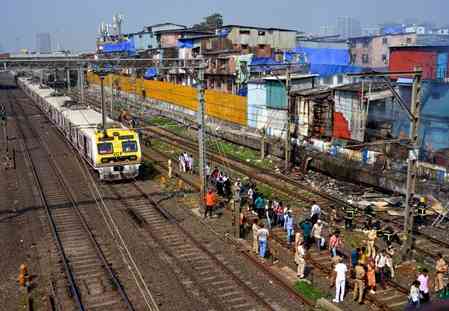RBI kept benchmark interest rate unchanged: Industry Reactions
Reserve Bank of India (RBI) on April 8, 2022 has kept the benchmark interest rate unchanged at 4 per cent. It has also decided to continue with its accommodative stance despite rising inflation. It may be mentioned here that this is the 11th time consecutively that the Monetary Policy Committee has maintained the status quo.

Reserve Bank of India (RBI) on April 8, 2022 has kept the benchmark interest rate unchanged at 4 per cent. It has also decided to continue with its accommodative stance despite rising inflation. It may be mentioned here that this is the 11th time consecutively that the Monetary Policy Committee has maintained the status quo. Here’s are the industry reactions:
“The apex bank of India has today announced that card less ATM withdrawals will be made available across all bank ATMs. Although some banks have ATMs which allow these transactions, RBI governor Mr. Shaktikanta Das has announced this facility will now be available across all bank ATMs, and will be using the Unified Payments Interface (UPI) platform for the disbursal of cash.
While the pandemic did act as a catalyst, digital transactions in our country have risen exponentially over the last few years because of increasing internet and smartphone penetration as well.
We consider ourselves to be fortunate to have been at the forefront of this change, and we understand that with this initiative, soon all users will have greater freedom to withdraw money at their own convenience, without being restricted by a physical ATM card. We welcome this announcement of making card less withdrawals available across all ATMs and believe that it will help us take another significant step towards creating an economy that is truly digital.”
- Dilip Modi, Founder, Spice Money.
“Against that complex economic backdrop prevalent at present, the RBI’s decision to retain the accommodative stance, while articulating a focus on gradual withdrawal of accommodation was warranted. At a time when inflation is rising and geopolitical tensions are leading to volatility in global markets and keeping energy and commodity prices elevated, the RBI has been bold and upfront in recognizing the risks to growth and inflation in FY23. The GDP growth projection for FY23 has been reduced by 60 bps and inflation estimate has been raised by a sharp 120 bps.
It is important to note that monetary policy typically takes effect with a lag. As per the RBI’s latest projection, inflation is estimated to average at around 5.25% in H2FY23, as against the earlier expectation of around 4%. While this doesn’t call for a kneejerk reaction at the moment, if the inflation projection for H2FY23 needs to be revised upwards, rather than downwards, going forward, it might lead the central bank to raise the Repo Rate earlier than what was earlier expected.
While the Reverse Repo rate was left unchanged today, introduction of SDF at a rate at 3.75%, effectively moves the floor of the LAF corridor higher. However, this shouldn’t lead to any fresh immediate upward pressure on near term rates as the latter already settled above the SDF rate as the RBI focused more on VRRR in recent months. Also, this move may not trigger any major surprise as the possibility of restoring the usual width of the LAF corridor had been well telegraphed by the central bank.”
- Siddhartha Sanyal, Chief Economist and Head of Research, Bandhan Bank
“The RBI’s decision to continue to maintain the repo rate and reverse repo rate at 4% and 3.35% comes as a positive move, at a time when the affordability factor of a home was being challenged due to rising construction costs. For homebuyers, this decision will help reinstate confidence and improve access to affordable home loans. The unchanged repo rate will continue to aid in infusing liquidity into the sector and in turn, provide the necessary impetus to sustain the growth of the residential real estate market.”
-Reeza Sebastian Karimpanal, President – Residential, Embassy Group
“Policy continues to have a ‘feel good’ stance from the point of view of durable recovery process. The projected numbers perhaps warrant more frequent revisits in the face of dynamically evolving operative environment, within and outside India.”
- Atanu Kumar Das, MD & CEO, Bank of India
“RBI continues on its exemplary act of balancing the contrasting pulls of its key objectives viz; price stability, growth support and easy financial conditions. While the key policy rates remain unchanged, restoration of LAF corridor to 25 bps below and above Repo rate, has effectively pushed up the short term rates by 40-50 bps. Similarly, while the monetary policy stance continues to be ‘accommodative’, the accompanying statement mentions its focus on ‘withdrawal of accommodation’ to match up with rising price pressures. Combined with substantial upwards revision of inflation forecasts for the current fiscal year to 5.7%, RBI has, to a large extent, re-aligned its policy to evolving market conditions and also signalled rate hikes over the year. Given the current macro dynamics, MPC announcements were a tight rope walk that has delivered on re-calibrating growth-inflation projections, signalling impeding hikes and still buying time to hike lending rates. With multiple risks on both inflation and growth trajectory in the current fiscal year, we expect two reluctant rate hikes, most likely starting in second quarter. Combined with gradual and calibrated liquidity withdrawal, we nevertheless, expect financing conditions to still remain easy over the full year, to support economic activities”.
- Rajni Thakur, Chief Economist, RBL Bank
“The credit policy has surprised the markets with aggressive changes in projections for both GDP and inflation. For GDP growth it is 7.2% (Bank of Baroda: 7.4-7.5%) while inflation has been increased to 5.7% (Bank of Baroda: 5.5-6%). There is a clear hint that the accommodative stance though retained will change as there will be a gradual withdrawal of liquidity keeping in mind the trends in inflation. The interesting introduction of the SDF notwithstanding the high level of bonds held by RBI does indicate that the overnight reverse repo would no longer be attractive as the SDF gives higher return. These are clear indications of the repo rate being increased during the course of the year and we do expect at least 50 bps increase this year. The markets have already reacted with the 10-year bond going up past 7% and we expect the rate to go up to 7.25% this year.”
– Madan Sabnavis, Chief Economist, Bank of Baroda
“Today's announcement by the Reserve Bank of India to rationalize the risk weightage on housing loans and link them to loan-to-value (LTV) ratios till March 2023, will boost the nation’s real estate sector. This announcement will encourage banks to continue lending more to individual homebuyers without feeling the stress on their balance sheets. It will effectively result in higher credit flow to the housing sector and eventually make the residential segment a lucrative investment for aspirational homebuyers.”
- Kamal Khetan, Chairman and Managing Director, Sunteck Realty Ltd
“The RBI has responded to both to the new inflation and growth challenges that have emerged due geopolitical tensions that have manifested themselves in rising commodity prices. While the RBI kept its monetary policy stance unchanged, it restored the policy corridor to pre-pandemic levels and provided a commitment towards a slow reduction of liquidity going forward.
This is clearly a hawkish policy as compared to the February meeting, justified by the inflationary pressures that have emerged over the past month. The upward inflation forecast revision by 120bps to 5.7% for FY23 seems sensible given the broad-based nature of price increases.
Despite the increase in HTM limits, bond yields are likely to go up given the sheer size of the borrowing program for FY23. We expect the 10 year to rise to 7-7.25% in H1 FY23.”
- Abheek Barua, Chief Economist, HDFC Bank
“The RBI statement reflects cautious optimism – focus on ensuring robust recovery before accelerating growth levers. The accommodative policy stance should nurture the credit markets – though the hint of a calibrated withdrawal may add a dash of uncertainty. Continued government borrowings should be directed towards delivering the infrastructure development promises of the government – this will certainly bolster the investment sentiment for India. Policy thrust on climate change risks and its criticality on sustainable financing – important development to be closely watched. The policy also provides adequate push for fintechs – both in terms of deepening the market and for enhancing security.”
-Soumitra Majumdar, Partner, J Sagar Associates JSA
"Repo Rate was last cut on 22nd May 2020 because of covid-induced lockdown which had a nationwide affect. Rates remains at a historic low of 4 percent since then. RBI Governor said projected growth of GDP for FY 2023 is at 7.3 %. 7.8 % was previously projected. Escalating geopolitical tensions has taken a toll on India’s growth prospects. This is keeping in mind that oil remains at 100 dollars per barrel. Inflation is projected at 5.7 percent higher than previous expectation of 4.5 percent."
- Rajni Thakur, Chief Economist, RBL Bank
“RBI monetary policy has fallen much within the expectations of a dovish stance in view of the current crisis and maintains it’s pro-growth outlook. The geopolitical scenario on the global front and soaring inflation have led the RBI to lower its growth forecast to 7.2 per cent from 7.8 per cent and an increase in the inflation forecast for the current FY. However, the strong Indian forex reserves and a stable financial sector is providing some relief to the dismay. The unchanged repo rate will provide more elbow room to the homebuyers and helps in the revival of the realty sector. To curb the uncontrollable inflation, RBI has increased the reverse repo rate and sharp increase in the inflation projection has hinted towards a possible tightening in the near future.”
- Dr. Ravi Singh, vice President and head of ResearchShareIndia
“RBI’s effort to keep the repo rate unchanged and maintain an accommodative stance is a welcoming step. This will continue to keep the home loan rates in the lower band, thereby fostering growth and pushing the market in a positive direction. Lowered home loan rates will also help renewed investor interest in the sector, as real estate is a prudent option for risk-averse investors. Meanwhile, the governing agencies should try to control inflation, otherwise, raw material prices will jump upwards and affect the industry.”
- Subhash Goel, chairman & MD, Goel Ganga Developments
“RBI monetary policy is as expected, with the accommodative stance remaining in place. However, the reverse repo rate has been raised, sucking liquidity from the market, but the outlook remains positive because the accommodative stance remains in place.”
- Ravi Singhal, Vice Chairman, GCL securities Limited
“The step by RBI to keep the repo rate unchanged is a prudent initiative, as it will enable banks to continue offering credit at low rates, thereby helping retail consumption. With receding cases, expansive vaccination drives, and a healthy economic outlook, India’s retail sector looks upbeat in FY 23. Meanwhile, the government should try to control inflation, because if not rein, it can soften demand.”
- Ridhima Kansal, Director, Rosemoore
“As per RBI announcement, Repo Rate has been kept unchanged at 4 percent. Reverse repo rate at 3.35 percent will also remain unchanged.”
- Manoj Dalmia, founder and director, Proficient equities Private limited
“The RBI played the role of the Good Samaritan by maintaining the status quo on rates despite inflationary pressure. There may be criticism from a macro-economic perspective, but we need to understand the fact that the RBI is playing a complex game of balancing growth with inflationary pressure. This could be elucidated from the fact that despite geopolitical pressure, the RBI had decided to hold its key lending rates steady at record low levels for the 11th straight meeting to support a durable recovery of the economy from the Covid-19 pandemic."
“From a real estate perspective, this is good news for home buyers as no change in the repo rate means home buyers can avail the decadal low interest rate for their new home purchases. At the same time, this will also be the last bus to buy property at the best price proposition as we anticipate that not only the interest rates but property prices are also going to rise by the next quarter.”
- Kaushal Agarwal, Chairman, The Guardians Real Estate Advisory
"For the first time since the pandemic, inflation has emerged as a bigger concern than growth for the RBI and therefore the decision was on the expected lines. The inflationary pressure is due to macro economic factors like the Russia- Ukraine war, disruptions of supply chain due to Covid and increase in wholesale commodity prices. Thus, by keeping the rates unchanged RBI has indicated that the domestic consumption is not to be blamed for the inflationary pressure and thus not burden the common man with higher interest rates. This will continue to boost the India consumption story and give a boost to the GDP of India.
In the past couple of years, the homebuyers have made the most of the rock-bottom interest rates on home loans along with offers from good developers and the upcoming occasions such as Akshaya Tritiya will fetch them yet another chance to do so. We have already started witnessing an upward revision in the property prices due to the rising construction costs and higher stamp duty as a result of the metro cess and ready reckoner rates. The lower-interest rates could prove to be yet another opportunity for the homebuyers to make their desired purchase. We are continuing to urge the Government to look into the rising prices in interest of the homebuyers."
- Pritam Chivukula, Co-Founder & Director, Tridhaatu Realty and Treasurer, CREDAI MCHI
"We welcome the RBI's decision of keeping the key rates unchanged amid the global uncertainties. This would encourage the prospective homebuyers to still close-in on their property investments. In the last couple of years, we have witnessed a lot of investment in real estate as it has provided the investors with more value for their money and it has also become an attractive asset class when compared to other investment options."
- Dr. Sachin Chopda - Managing Director, Pushpam Group
"RBI maintaining status quo on key policy rates was anticipated given the inflationary concerns in recent months along with the macro-economic factors like the Russia-Ukraine war and the hike in the commodity prices. Considering the global scenario, the decision will help to sustain liquidity for some more time which will augur well for the real estate sector and the overall economy. We have already started seeing a vertical movement in the home prices and the decision will therefore help in enhancing the confidence of the homebuyers."
- Shraddha Kedia-Agarwal, Director, Transcon Developers
"It was on the expected lines that the RBI will keep rates unchanged and maintain its accommodative stance in its first MPC meet for the new financial year considering the rising inflation on account of geopolitical developments. The Government has always taken affirmative measures towards the recovery of the economy with sustained fiscal & monetary support. With the prevailing low home loan rates for homebuyers, the real estate sector has already been immensely benefited. This decision will further boost the consumer sentiments while sustaining the growth momentum in upcoming months."
- Bhushan Nemlekar, Director, Sumit Woods Limited
''Keeping in mind the economic concerns owing to the inflation amid the global uncertainties in near future, we welcome the RBI's decision to continue with their accommodative stance. The measures announced were much needed to amplify the liquidity in the economy and are considered as a progressive step towards the revival of the real estate sector. The RBI's decision will boost the homebuyers' confidence to make their purchase of owning a dream home."
- Jitesh Lalwani, President, Home Sync Real Estate Advisory
"In spite of pressures due to elevated levels of inflation amid the global turbulence caused mainly by the on-going Russia-Ukraine war, the RBI has maintained an accommodative stance to insulate the economy by keeping the inflation within the target range while supporting economic development. The RBI has ensured that the growth remains unhindered without any further deceleration. It has also attempted to normalise the liquidity corridor by introducing a long-awaited Standing Deposit Facility, which may absorb excess liquidity from the banks. It has also hinted at gradual and calibrated withdrawal of liquidity in a non-disruptive manner beginning this fiscal. On the real estate front, the crude prices - led inflation coupled with rising costs of material, increase in metro cess, ready reckoner and stamp duty rates, etc have a huge bearing on the real estate pricing. While the sector needs more liquidity, it equally needs a breather for rising costs.
We, at NAREDCO, have requested the Ministry of Housing & Urban Affairs to immediately look into the rising prices of the raw materials to curb the increased difficulties faced by realtors and home buyers, we are approaching the RERA authorities to consider this scenario as a Force Majeure and to allow the escalation in selling prices of the properties; so that the Government's mission of 'Housing for All' to provide affordable housing fares well in these challenging times."
- Sandeep Runwal, President, NAREDCO Maharashtra
“In line with market expectations RBI Monetary policy Committee, kept the repo rate unchanged at 4% and continued with accommodative stance. Given the current Geopolitical situation the increasing inflation projections and reducing growth outlook was also expected.
To impart flexibility in liquidity management, Reserve Bank of India has tweaked its liquidity framework, introducing standing deposit facility through which it will absorb surplus liquidity. As the economy is limping back to normalcy RBI restores, LAF corridor to 50 bps as in pre-covid level with SDF as floor at 3.75% and MSF as ceiling at 4.25% which will also provide financial stability. Increasing SLR holding in Held-to-Maturity category by 100 bps till March 31, 2023 banks will be able to better manage their investment portfolio.
With diversification in financial industry, RBI proposal of a panel to review status of customer service at RBI-regulated entities was a necessary step. Cardless cash withdrawal now being available at all bank branch and ATMs via UPI will help prevent frauds and improve ease of transactions. Rationalisation of risk weights for individual housing loans to be extended till March 31, 2023 which will provide impetus to Housing loan demand.”
- Atul Kumar Goel, MD and CEO of Punjab National Bank (PNB)
"The move by the RBI to maintain a status quo was on expected lines due to the growing uncertainties in the market. Lower home loan interest rate was one of the major factors for pushing real estate sales in the last two years of the pandemic. The decision will further help boost the confidence of new homebuyers, who would still want to avail the benefits of reduced interest rates before the developers pass on the additional burden of input costs to the homebuyers."
_ Rahul Pande - Director, Justo Realfintech Pvt. Ltd.
“The RBI’s move to keep the repo rate and the reverse repo rate unchanged (4% and 3.35%, respectively) is assuring, particularly in the interest of the homebuyers.
As a result, the home loan rates remain unimpacted. This is favourable for customers, especially when there has been a surge in real estate prices due to rising input costs. Hence, the sustained accommodative stance will enable buyers to finalise property deals before further price spikes. This, in turn, would have a positive impact on the residential real estate segment and the overall economy.”
- Ashish Puravankara, Managing Director, Puravankara Limited
“The MPC sensibly decided to keep monetary policy accommodative despite inflation being marginally above its tolerance band. Two good reasons justify the policy: (a) inflation is high partly because of (external) supply shocks, so reducing aggregate demand (through monetary tightening) will not address the issue; (b) there is a considerable output gap, with the economy having contracted 6.6% in FY21, and estimated to have grown 8.9% in FY22 (far from closing the gap, in an economy with potential growth of 7% annually). Staying accommodative is thus the right approach: loan growth needs to accelerate to enable a rebound in domestic demand, but the RBI will also withdraw accommodation tactically if inflation gets too far from the target.”
- Prasenjit Basu – Chief Economist, ICICI Securities
“Even though RBI has maintained the accommodative stance and kept the benchmark rates unchanged the policy is likely to result in upward movement in yields. The higher inflation projection and shifting of policy corridor to SDF would lead to higher bond yields.”
- Sampath Reddy, Chief Investment Officer, Bajaj Allianz Life Insurance
“Amidst the 'tectonic' shifts in global conditions, RBI has taken more than one step towards preparing the market for an eventual increase in the repo rate. This position is made clear as the governor indicated that the order of preference for RBI now is inflation, growth and financial stability, rather than the post COVID-19 preference of preserving and supporting growth momentum. The process of neutralizing monetary policy had already started with withdrawal of ultra-comfortable liquidity. In this policy, the operative rate was increased by 40bps with the institutionalization of the Standing Deposit Facility. With this, RBI has almost buried the reverse repo as an instrument. Towards the objective of an orderly completion of the government’s borrowings, the HTM limit was increased by 1% to 23%. Overall, we now expect the stance to be made 'NEUTRAL' in June and the first repo rate increase can come through in August.”
- Indranil Pan - Chief Economist, YES Bank


 cityairnews
cityairnews 










